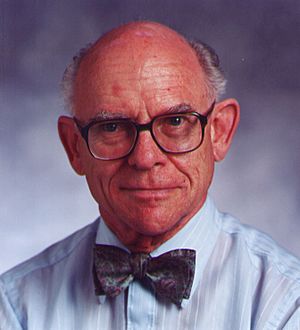F. Albert Cotton facts for kids
Quick facts for kids
Frank Albert Cotton
|
|
|---|---|

Cotton in August 2005
|
|
| Born | April 9, 1930 Philadelphia, Pennsylvania, U.S.
|
| Died | February 20, 2007 (aged 76) College Station, Texas, U.S.
|
| Citizenship | USA |
| Alma mater | Harvard University |
| Awards | William H. Nichols Medal (1975) National Medal of Science (1982) NAS Award in Chemical Sciences (1990) Priestley Medal (1998) Wolf Prize (2000) FRS |
| Scientific career | |
| Fields | Inorganic Chemistry |
| Institutions | Massachusetts Institute of Technology Texas A&M University |
| Doctoral advisor | Geoffrey Wilkinson |
| Doctoral students | Richard H. Holm, Stephen J. Lippard, Charles B. Harris, Tobin J. Marks, Hong-Cai (Joe) Zhou, John J. Wise, Walter G. Klemperer, John P. Fackler, Jr., Tong Ren, Richard D. Adams |
| Other notable students | Ada Yonath, Kim Renee Dunbar, Rinaldo Poli |
Frank Albert Cotton (April 9, 1930 – February 20, 2007) was a very important American chemist. He was a top professor of chemistry at Texas A&M University. He wrote more than 1600 scientific papers! Cotton was famous for his amazing work on the chemistry of transition metals. These are special metals like iron and copper.
Contents
Early Life and School
Frank Albert Cotton, often called "Al," was born in Philadelphia, Pennsylvania, on April 9, 1930. He went to local public schools. Later, he studied at Drexel University and Temple University.
In 1951, he earned his first degree from Temple. Then, he went to Harvard University to get his Ph.D. (a very advanced degree). He studied under a famous scientist named Sir Geoffrey Wilkinson. Cotton finished his Ph.D. in 1955.
Amazing Career in Chemistry
After finishing his studies at Harvard University, Cotton started teaching at Massachusetts Institute of Technology (MIT). In 1961, when he was just 31, he became the youngest person ever to be a full professor at MIT. This was a huge achievement!
His work at MIT focused on how atoms are put together and how to make new chemicals. He was a pioneer in studying how transition metal atoms can bond together in special ways. He was the first to identify a "quadruple bond" in a chemical called Re2Cl2−
8. This means four bonds hold two metal atoms together, which was a big discovery!
Cotton also used a method called X-ray diffraction. This tool helps scientists see the exact structure of molecules. He showed that many metal complexes could change their shape quickly. He even invented the term "hapticity" to describe how some atoms attach to molecules.
In 1972, Cotton moved to Texas A&M University. There, he became a distinguished professor of chemistry. He also led the university's Laboratory for Molecular Structure and Bonding.
Teaching and Mentoring
Besides his research, Professor Cotton was a dedicated teacher. He taught inorganic chemistry, which is the study of chemicals that don't contain carbon.
He wrote a very important textbook called Chemical Applications of Group Theory. This book helps students understand how math can explain chemical bonds.
He also co-wrote another famous textbook, Advanced Inorganic Chemistry. This book, often called "Cotton and Wilkinson," is used by college students all over the world. It covers many topics in chemistry.
Cotton was also a leader in the scientific community. He served on the boards of many science journals. He also guided the research of 116 students getting their doctoral degrees. He also mentored over 150 postdoctoral researchers.
Awards and Honors
Frank Albert Cotton received many top awards for his work. These included:
- The U.S. National Medal of Science in 1982.
- The Wolf Prize in 2000.
- The Priestley Medal in 1998, which is the highest award from the American Chemical Society.
In 1995, a special award was created in his honor: the F.A. Cotton Medal for excellence in chemical research. Another award, the F. Albert Cotton Award for Synthetic Inorganic Chemistry, is given out every year.
Cotton was a member of many important science groups. These included the United States National Academy of Sciences. He also received 29 honorary doctorates from different universities.
F.A. Cotton Medal for Excellence in Chemical Research
The F.A. Cotton Medal was started in 1994. It is given each year by the Texas A&M Section of the American Chemical Society. This medal celebrates great achievements in chemical research. The award was created to honor Frank Albert Cotton, and he received the first medal in 1995.
Death
Frank Albert Cotton passed away on February 20, 2007, in College Station, Texas. He was 76 years old. He was survived by his wife, Diane Dornacher, and their two daughters, Jennifer and Jane.
See also
- List of chemistry awards

